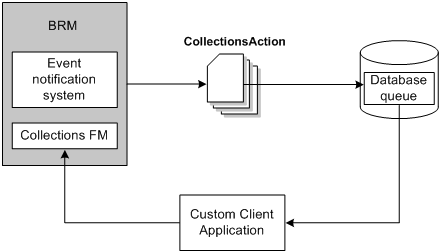11 Integrating Collections Manager with Custom Client Applications
Learn how to integrate your custom application with Oracle Communications Billing and Revenue Management (BRM) Collections Manager.
Topics in this document:
About Integrating Collections Manager with Custom Client Applications
To enable a custom client application to manage collections activities:
-
Configure BRM to send collections notification events to your custom client application. See "Sending Collections Notifications to Custom Client Applications".
-
Customize your client application to call the Collections opcodes. See "Collections Opcode Workflows" in BRM Opcode Guide.
-
(Application Integration Architecture systems only) Configure the pin_collections_process utility to publish a CollectionsInfoChange business event.
Collections Manager can be integrated with a custom client application, such as Siebel CRM, so customer service representatives (CSRs) can track and manage collections activities directly in the custom client application.
The custom client application manages collections activity, such as preparing dunning letters or applying late fees, by calling the Collections FM. Collections Manager notifies the custom client application when a collections activity occurs, such as an account entering collections, by using the BRM event notification system. Figure 11-1 shows how data is passed.
Figure 11-1 How Custom Client Applications Communicate with Collections Manager

Description of "Figure 11-1 How Custom Client Applications Communicate with Collections Manager "
To integrate Collections Manager with a custom client application:
-
Configure the custom client application to call the Collections Manager opcode. See "About Calling the Collections Manager API".
-
Configure Collections Manager to notify the custom client application when collections information changes. See "About Notifying Custom Client Applications when Collections Activity Occurs".
About Calling the Collections Manager API
CSRs need to perform the following collections tasks in their custom client application:
-
Manage the collection of overdue balances
-
Retrieve information about collections activities
-
Perform manual collections activities
-
Prepare dunning letters for customers
To perform these tasks, you must configure your client application to accept the required information and pass it to the Collections Manager opcodes. You can determine the information required by looking at the target opcode's input flist. For more information, see "Using the Collections Manager API" in BRM Opcode Guide.
Note:
You can pass information to Collections Manager opcodes either directly from the custom client application or through Oracle Application Integration Architecture (Oracle AIA). For more information about Oracle AIA, see "Using BRM with Oracle Application Integration Architecture" in BRM Developer's Guide.
About Notifying Custom Client Applications when Collections Activity Occurs
Collections Manager uses event notification to alert custom client applications when collections activities occur, such as an account entering collections or a dunning letter being sent. Collections Manager sends an alert in the form of an /event/audit/collections/action notification event, which includes information about the collections action, such as:
-
The POID of the /collections_action object
-
The action type: manual, custom, or system
-
A description of the action
-
The action status
To notify custom client applications when collections activity occurs:
-
Configure BRM to publish /event/audit/collections/action notification events. See "Sending Collections Notifications to Custom Client Applications".
-
Customize your client application to retrieve notification events from the database queue.
Creating CollectionsInfoChange Business Events
If your custom client application connects to BRM through Oracle Application Integration Architecture (Oracle AIA), BRM must publish CollectionsInfoChange business event to the AQ database queue when a collections job has run.
To create a CollectionInfoChange business event:
-
Open the pin_collections_process configuration file (BRM_home/apps/pin_collections/pin.conf) in a text editor.
-
Add a publish_run details entry and set it to 1:
- pin_collections_process publish_run_details 1 -
Save and close the file.
Sending Collections Notifications to Custom Client Applications
You can configure BRM to synchronize collections data with your custom client application. To do so, you must:
-
Create Oracle Advanced Queuing (AQ) database queues
-
Configure event notification to trigger calls to opcodes when /event/notification/collections/action and /event/notification/collections/info_change events occur
-
Configure the Payload Generator EM to build CollectionsAction and CollectionsInfoChange business events and send them to the Oracle DM
-
Map the CollectionsAction and CollectionsInfoChange business events to your database queues
To set up your system to send collections notifications to custom client applications, follow the instructions in "Configuring Your AQ Database Queues" in BRM System Administrator's Guide using the configuration files shown in Table 11-1.
Table 11-1 Configuration Files for Collections Notifications
| File Type | File Name and Location | Action |
|---|---|---|
|
Event notification file |
BRM_home/sys/data/config/pin_notify_collections |
Use this file or merge it with your existing event notification file, and then load the final file into the database. |
| Payload configuration file |
BRM_home/sys/eai_js/payloadconfig_collections.xml |
Use this file or merge it with your existing payload configuration file. |
|
Business event-to-queue mapping file |
BRM_home/sys/dm_oracle/aq_event_map |
Uncomment these business events in the file:
|